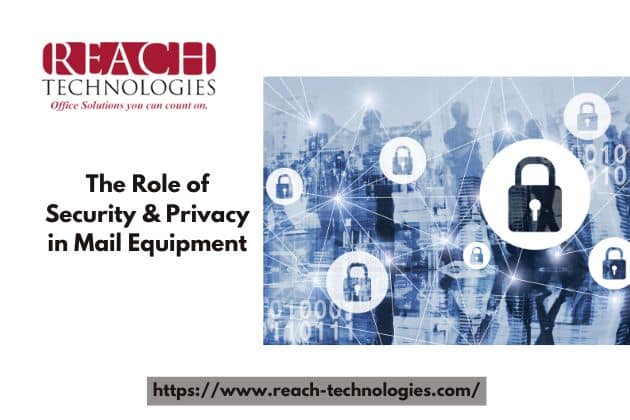
In today’s digital-first business environment, security and privacy are more than just compliance checkboxes — they are essential pillars of trust, integrity, and operational continuity. As organizations continue to rely on mailroom automation, document handling systems, and digital mail solutions, protecting sensitive data becomes a non-negotiable priority. Modern mail equipment must now meet the dual challenge of delivering efficiency and robust data protection in every transaction.
Understanding the Importance of Mail Security
Every piece of mail — whether physical or digital — can carry confidential business data, client information, or financial details. Unauthorized access, interception, or manipulation of this information can result in data breaches, compliance violations, and loss of client trust.
To mitigate these risks, companies must adopt advanced mail equipment integrated with built-in security features such as encryption, secure authentication, and tamper-proof systems. These measures ensure that sensitive correspondence remains protected from the moment it’s generated to the moment it’s delivered.
Data Privacy Regulations and Mail Handling
With global data protection laws like GDPR, HIPAA, and CCPA, organizations are legally obligated to protect customer data throughout its lifecycle. Mail equipment now plays a critical role in compliance management.
Modern systems support:
-
Data encryption and masking for printed and digital communications
-
Secure audit trails that record every access and transaction
-
Role-based access control (RBAC) ensuring only authorized personnel handle specific mail items
-
Automatic data purging after a defined retention period to minimize data exposure
These capabilities not only protect businesses from penalties but also demonstrate corporate accountability and customer trustworthiness.
How Technology Enhances Mail Equipment Security
The evolution of mailroom technology has ushered in intelligent systems that go beyond sorting and scanning. Today’s mail equipment incorporates:
-
End-to-end encryption for scanned or digitized documents
-
AI-powered anomaly detection to flag suspicious activity
-
Blockchain verification for authenticity and traceability
-
Cloud-based security protocols that safeguard digital archives from external breaches
Such innovations ensure that every document processed through mail equipment maintains integrity, confidentiality, and traceability, meeting even the most stringent enterprise security requirements.
Physical Mail Equipment and Secure Design
While digital transformation dominates discussions on data privacy, physical mail equipment continues to play a vital role — especially in industries like finance, healthcare, and government. Here, the focus extends to the physical design and operational security of mailing devices.
Leading equipment manufacturers now feature:
-
Locked access compartments for sensitive mail
-
User authentication (PIN or biometric) before operating or accessing the machine
-
Tamper-evident seals and built-in shredding mechanisms for confidential disposal
-
Secure mailing logs that track user activity for audits
By merging hardware integrity with software intelligence, organizations ensure multi-layered protection that addresses both physical and cyber threats.
The Role of User Authentication and Access Control
Unauthorized usage of mail equipment can result in data leaks, misuse of postal accounts, or fraudulent communications. To counter this, modern systems integrate authentication and user-level tracking technologies.
Common access control mechanisms include:
-
Smart card authentication for identity verification
-
Biometric login for high-security environments
-
Network-based permissions that limit who can print, scan, or send specific documents
These measures ensure that every mail operation is accountable, auditable, and secure, aligning perfectly with corporate governance policies.
Integration with Secure Digital Ecosystems
In a connected workplace, mail equipment often integrates with enterprise software, such as CRM systems, ERP platforms, and cloud-based storage. This interconnectedness, while convenient, opens new potential attack surfaces.
To maintain strong security posture, integration must include:
-
Secure API connections using token-based authentication
-
Regular software updates to patch vulnerabilities
-
Zero-trust architecture ensuring no device or user is automatically trusted
-
Encrypted data transmission during system interactions
Organizations investing in secure mail ecosystems future-proof their operations against data theft, ransomware, and insider threats.
Mail Equipment in Remote and Hybrid Work Environments
With hybrid work becoming the norm, the demand for remote-access mail solutions has surged. Employees now access mail data, print jobs, and scanning services from multiple locations — increasing the potential for data breaches if not properly managed.
To address this, modern mail equipment supports:
-
Secure mobile printing with user authentication
-
Encrypted cloud document sharing
-
Remote device management for IT teams to monitor and revoke access as needed
-
Geo-fencing policies restricting usage to approved locations
Such security-driven flexibility allows organizations to maintain productivity without compromising privacy — a balance critical in the modern business world.
Proactive Maintenance and Security Updates
Even the most secure mail systems are only as safe as their latest update. Regular maintenance and firmware upgrades play a crucial role in defending against emerging cyber threats.
Businesses should implement:
-
Scheduled security patches for all connected mail devices
-
Routine vulnerability assessments
-
Comprehensive data backup strategies
-
Employee training on secure mail handling
By combining preventive maintenance with robust security policies, organizations safeguard their communication infrastructure from both internal mishandling and external attacks.
Why Security & Privacy Influence Purchasing Decisions
When evaluating mail equipment, security and privacy capabilities have become as important as cost and performance. Buyers now prioritize:
-
Compliance-ready features
-
Encryption standards and data protection certifications
-
Vendor reputation in cybersecurity
-
Integration with existing secure networks
Choosing secure mail equipment isn’t just about protection — it’s about maintaining business continuity, brand credibility, and customer confidence in a competitive digital environment.
Conclusion: Secure Your Mailroom with Reach Technologies
At Reach Technologies, we understand that security and privacy are fundamental to modern communication. Our mail equipment solutions are engineered with advanced encryption, secure authentication, and compliance-grade data protection, ensuring every piece of mail is handled with the utmost care and confidentiality.
We partner with businesses to deliver reliable, secure, and efficient mail systems that meet the evolving standards of today’s digital ecosystem.
Contact Reach Technologies today to discover how our secure mail equipment solutions can protect your organization’s data, streamline operations, and give you peace of mind in every message sent and received.
